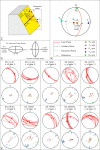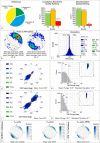QUaternary fault strain INdicators database - QUIN 1.0 - first release from the Apennines of central Italy
- PMID: 35551216
- PMCID: PMC9098408
- DOI: 10.1038/s41597-022-01311-8
QUaternary fault strain INdicators database - QUIN 1.0 - first release from the Apennines of central Italy
Abstract
We present QUIN, a "QUaternary fault strain INdicators database", designed to integrate and unify published and unpublished local-scale geological information and derive strain parameters for structural and seismotectonic analyses. It provides data on 3339 Fault Striation Pairs (FSP; fault plane and slickenline), distributed within 455 survey sites. These are exposed along the intra-Apennine Quaternary extensional faults of Central Italy. The area covers an extent of ~550 km in a NW-SE direction. We give information on FSP location, attitude and kinematics, and deformation axes. We also provide an original shapefile of the faults hosting the FSP. A large amount of homogeneously distributed Quaternary fault/slip data help to clarify and implement the contemporary geometric and kinematic deformation pattern of Central Italy that appears scattered and incomplete whenever exclusively derived from earthquake data. The high-density of structural data can help investigate stress pattern heterogeneities at local scales, with relevance for new generations of hazard assessment evaluation and a better understanding of rupture propagation and related barriers.
© 2022. The Author(s).
Conflict of interest statement
The authors declare no competing interests.
Figures




References
-
- Heidbach O, et al. The World Stress Map database release 2016: Crustal stress pattern across scales. Tectonophysics. 2018;744:484–498. doi: 10.1016/j.tecto.2018.07.007. - DOI
-
- Heidbach, O. et al. Plateboundary forces are not enough: Second- and third-order stress patterns highlighted in the World Stress Map database. Tectonics26 (2007).
-
- Barchi, M. R. The Neogene-Quaternary evolution of the Northern Apennines: crustal structure, style of deformation and seismicity. J. Virtual Explor. 36 (2010).
-
- Carminati E, Fabbi S, Santantonio M. Slab bending, syn‐subduction normal faulting, and out‐of‐sequence thrusting in the Central Apennines. Tectonics. 2014;33:530–551. doi: 10.1002/2013TC003386. - DOI
LinkOut - more resources
Full Text Sources

